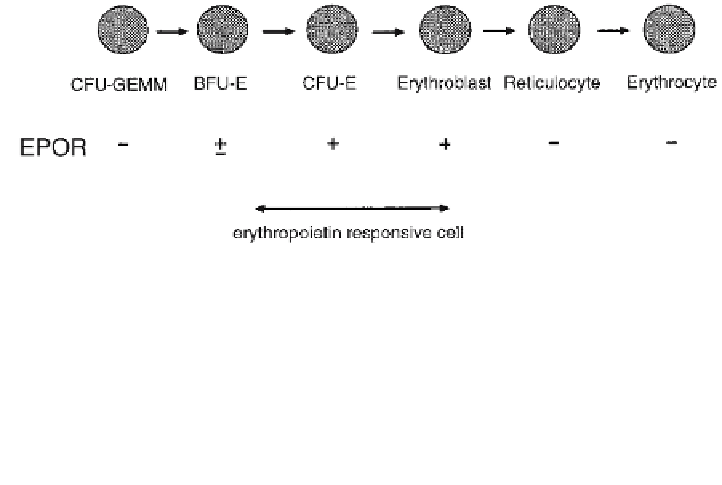Biology Reference
In-Depth Information
Figure 1. Cellular erythropoiesis. Erythroid cells are produced from a cellular lineage that progresses
from cells which are multipotential (CFU-GEMM = colony-forming unit-granulocyte, erythrocyte,
megakaryocyte, macrophage: a cell detectable by its ability to form a colony of cells in culture which
contains all of these cell lineages), to lineage committed cells of high proliferative capacity
(BFU-E = erythroid burst-forming unit), to those lineage committed cells of lower proliferative poten-
tial (CFU-E = erythroid colony-forming unit), to those cells that are recognizably hemoglobinized
(erythroblast, reticulocyte and erythrocytes). Figure courtesy of Amgen Inc., Thousand Oaks,
California.
absent on reticulocytes and mature erythrocytes [34]. EPOR
+
progenitor cells
have somewhat different cytokine dependencies in culture, with CFU-E requir-
ing the addition of only EPO, and BFU-E requiring EPO and more primitive-
acting cytokines previously known collectively as burst-promoting activities.
The burst-forming activities are now molecularly identified as materials such
as stem cell factor (SCF), interleukin-3 (IL-3), granulocyte-macrophage
colony-stimulating factor (GM-CSF), and IL-6 among others, or occasionally
mixtures of all or some of these.
Once EPO has engaged EPOR, a cascade of events is set in motion includ-
ing activation of the dimerized receptor [35], and signal transduction through
protein kinase C [36, 37], JAK-2, and Stat5 (reviewed in Frank [38] and
Cheung and Miller [39]). (See Chapters 3 and 5 for further information.) The
actions of EPO include promotion of the survival of sensitive progenitors
through prevention of apoptotic processes [40, 41], stimulation of proliferation
[42, 43], and differentiation into large numbers of hemoglobinized cells. To
maintain homeostasis and supply the necessary number of erythrocytes, the
degree of proliferation required is quite remarkable, and occurs in parallel with
the acquisition of features of the specialized functions of erythrocytes - accu-
mulation of hemoglobin and disposal of the cell nucleus.
As discussed, EPO does not act alone to stimulate erythropoiesis in the bone
marrow. A host of other agents have been shown to affect EPO-driven ery-
thropoiesis. As outlined in Chapter 1 and Figure 1, the hierarchy of cell popu-
lations leading to erythrocyte production includes successively more special-
ized cell types. Many of the co-factors in erythropoiesis act on these more
primitive cells, although at least one (erythroid cell-stimulating factor) appears
to act in concert with EPO on late-stage erythroid cells [44]. Among the prim-






